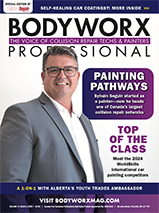PRODUCT PRECISION
WE DON’T FOOL AROUND WHEN IT COMES TO YOUR EQUIPMENT DECISIONS
BY ALLISON ROGERS
As I sit down to write this, I have only just returned from the spectacular SEMA Show in Las Vegas. This year was not my first time—it was my second, in fact—but it sure felt a lot different from last year.
This year, the SEMA Global Media Awards team reached out to ask if I would be a judge for their annual program. The team selects a panel of international journalists— Canada, Chile, Finland and South Korea were just a few of the countries represented— who then each select a list of ten products they believe would create the most impact in their home markets. In my previous years covering SEMA, I’ve marvelled at the products on display in the New Products Showcase. In previous years, it was situated near our booth in South Hall Upper, which made a midday walk through the shiny new bells and whistles an easy feat. This year, however, it was in the North Hall—and anyone who has been to SEMA (or has any basic sense of direction) knows that can be a bit of a trek. And I was wearing heels.
The Global Media Awards coordinators advised judges to put aside at least 30 minutes to adequately select our lists of 10 stellar products. I brought our marketing coordinator along for support, and made him peruse the thousands of new products on display for more than 90 minutes.
I was serious about making the right decisions. I made my list and checked it twice. The Global Media Awards were held the following evening, but the award recipients received manilla envelopes with the news of their victories the morning prior to the event. It was like Christmas morning hearing the buzz from the winning booths; one of my colleagues returned to our booth all giddy that one of my selections had received the envelope right in front of her eyes. We were all excited, to say the least. At the actual awards, I was pleased that almost all of my selections stopped by for a chat. It was incredible to learn of all the trial and error behind these products; the years of development behind them all. I already knew our industry was passionate— I talk to bodyshop owners, technicians, painters, educators, et cetera, every single day, and you can see it in every single one of them. But seeing that the minds behind our tools are just as dedicated as those with their hands on the vehicles—it only made my feelings on the industry that much stronger.
The same precision has gone into selecting the products between the pages of this catalogue. Our editorial team spends months each year perusing the web, calling our contacts and chatting with the industry on what products deserve placement in our guide. They are meticulously chosen; this guide can be an incredible tool, when used correctly. So—get to it!























